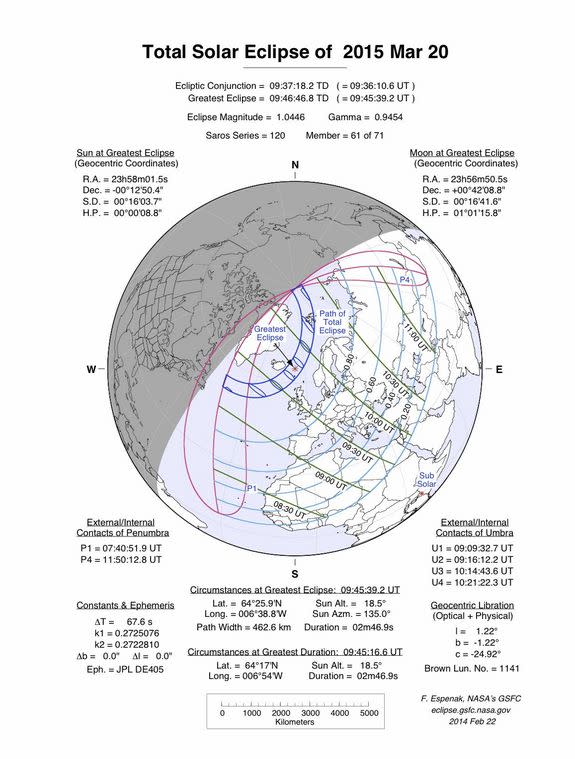Total Solar Eclipse on Friday: How to Watch It Live Online
Editor's Note for March 20 at 7:24 a.m. EDT: The total solar eclipse is over, but you can see amazing images of the cosmic event now. Full story - Spectacular Total Solar Eclipse Kicks Off First Day of Spring (Photos)
Even though most people around the world won't be able to see Friday's total solar eclipse in person, anyone with an Internet connection can watch it live online thanks to two webcasts featuring the cosmic event.
The March 20 total solar eclipse — the first since November 2013 — will make the daytime sky go dark for people in the Faroe Islands and parts of the North Atlantic. Weather permitting, the online Slooh Community Observatory will broadcast live views of the solar eclipse along with expert commentary from the Faroe Islands. You can watch the 2.5-hour-long solar eclipse webcast through the Slooh website starting at 4:30 a.m. EDT (0830 GMT) on March 20.
You can also watch the total solar eclipse webcast live on Space.com, courtesy of Slooh. A second webcast will also be available via the Italy-based Virtual Telescope Project at 4 a.m. EDT (0800 GMT) and can be found at the VTP website, as well as Space.com if possible.[How to Safely Watch the Total Solar Eclipse]
"Nothing — and I mean absolutely nothing in nature — is as powerful and spectacular as the totality of a solar eclipse," Slooh astronomer Bob Berman said in a statement. "Sadly, they only happen every 360 years on average for any given location, which means that a very low percentage of the population has ever seen one. This time, the moon's shadow sweeps over the remote Faroe Islands of the North Atlantic. Slooh has sent a team equipped with specialized, proprietary equipment to bring this spectacle live to the rest of our planet. This event should not be missed."
Total solar eclipses occur when the moon passes between the sun and Earth, blotting out the star for some observers lucky enough to be in the right place at the right time on the planet. Very few people will be able to see the moon total eclipse the sun during tomorrow's cosmic event, but many observers in other parts of the world will have the chance to see a partial eclipse.
WARNING: Never look directly at the sun without special equipment, even during a total solar eclipse. Permanent or serious eye damage can occur when looking directly at the sun without proper protection. If you're in the eclipse zone, be very careful. You can build a pinhole camera or solar projector with binoculars to safely observe the eclipse.
Some skywatchers in Europe, northern Africa and northern Asia could see as much as 99 percent of the sun blotted out by the moon Friday, according to Space.com skywatching columnist Joe Rao. If you want to find eclipse times specific to your area, check out EclipseWise.
Editor's Note: If you have an amazing photo of last night's aurora or any other night sky view that you'd like to share for a possible story or image gallery, please contact managing editor Tariq Malik at spacephotos@space.com.
Follow Miriam Kramer @mirikramer. Follow us @Spacedotcom, Facebook and Google+. Original article on Space.com.
Copyright 2015 SPACE.com, a Purch company. All rights reserved. This material may not be published, broadcast, rewritten or redistributed.



